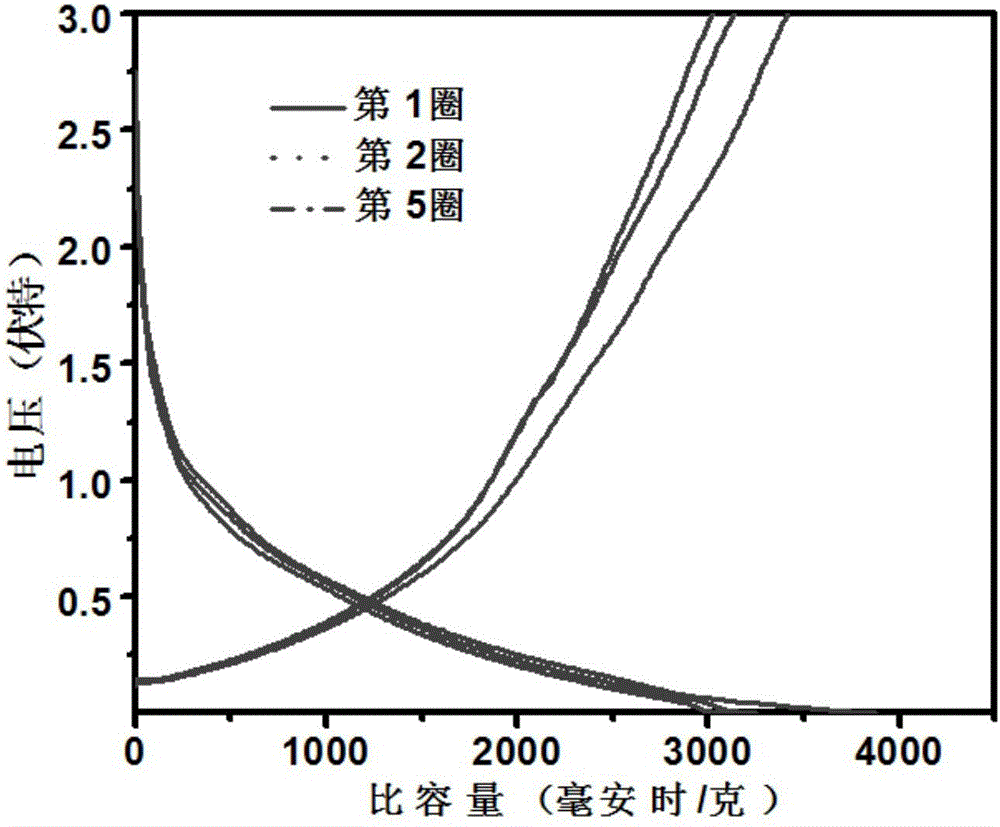Preparation method of cobalt diiron tetraoxide-carbon cloth lithium battery anode material
A technology of cobalt ferrite and negative electrode materials, which is applied in battery electrodes, circuits, electrical components, etc., can solve the problems of difficulty in meeting the needs of high specific energy lithium-ion batteries, limited discharge specific capacity, and small theoretical specific capacity. To achieve the effects of outstanding cycle stability, simplified manufacturing process, and high capacity
- Summary
- Abstract
- Description
- Claims
- Application Information
AI Technical Summary
Problems solved by technology
Method used
Image
Examples
preparation example Construction
[0039] The preparation method of the lithium battery negative electrode material of cobalt ferrate-carbon cloth of the present invention, comprises the following steps: provide a Prussian blue solution, the raw material of described Prussian blue solution comprises cobalt salt and ferricyanide; impregnating the carbon cloth with the blue solution to obtain a precursor / carbon cloth composite material; and performing heat treatment on the precursor / carbon cloth composite material.
[0040] The above term "Prussian blue" has the chemical formula Fe 7 (CN) 18 14H 2 O, or as Fe 4 [Fe(CN) 6 ] 3 ·nH 2 O, the chemical name is (OC-6-11)-hexacyanoferrate (4-) iron (3+) (3:4), also known as Berlin blue, tribute blue, iron blue, Milori blue, Asia Ferricyanide, Chinese blue, Miroli blue, Hualan.
[0041] Among the raw materials of the above-mentioned Prussian blue solution, the mass ratio of cobalt salt and ferricyanide salt is preferably 1:4 to 2:1, such as 1:4, 1:3.8, 1:3.5, 1:3, ...
Embodiment 1
[0063] Step 1. Pretreatment of carbon cloth activation. Specifically, the carbon cloth was first added to a hydrochloric acid solution with a concentration of 10wt% at a temperature of 90°C for 1 hour; then washed with deionized water and acetone respectively, and then dried at 70°C for 3 hours for later use.
[0064] Step 2, preparation of Prussian blue precursor. Specifically, according to the ratio, that is, the mass ratio of cobalt salt to iron salt is 2:3, the mass ratio of cobalt salt to water is 1:60, the mass ratio of iron salt to water is 1:75, and the surfactant and iron The mass ratio of salt is 1:0.7. Dissolve a certain amount of cobalt chloride and potassium ferrocyanide in deionized water respectively. After the two water solutions are mixed together, add a surfactant and stir for 4 hours to obtain a Prussian blue solution.
[0065] Step 3, preparation of the composite material. Specifically, pour the Prussian blue solution obtained in step 2 into a hydrotherma...
Embodiment 2
[0068] Step 1. Pretreatment of carbon cloth activation. Specifically, the carbon cloth was first added to a hydrochloric acid solution with a concentration of 5wt%, at a temperature of 85°C, and treated for 1.5h; then washed with deionized water and acetone, and then dried at 65°C for 5h for later use.
[0069] Step 2, preparation of Prussian blue precursor. Specifically, according to the ratio, that is, the mass ratio of cobalt salt to iron salt is 1:4, the mass ratio of cobalt salt to water is 1:50, the mass ratio of iron salt to water is 1:80, and the surfactant and iron The mass ratio of salt is 1:0.3. Dissolve a certain amount of cobalt chloride and potassium ferrocyanide in deionized water respectively, mix the two water solutions together, add a surfactant and stir for 4 hours to obtain a Prussian blue solution.
[0070] Step 3, preparation of the composite material. Specifically, pour the Prussian blue solution obtained in step 2 into a hydrothermal kettle, then imm...
PUM
 Login to View More
Login to View More Abstract
Description
Claims
Application Information
 Login to View More
Login to View More - Generate Ideas
- Intellectual Property
- Life Sciences
- Materials
- Tech Scout
- Unparalleled Data Quality
- Higher Quality Content
- 60% Fewer Hallucinations
Browse by: Latest US Patents, China's latest patents, Technical Efficacy Thesaurus, Application Domain, Technology Topic, Popular Technical Reports.
© 2025 PatSnap. All rights reserved.Legal|Privacy policy|Modern Slavery Act Transparency Statement|Sitemap|About US| Contact US: help@patsnap.com

